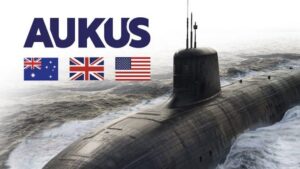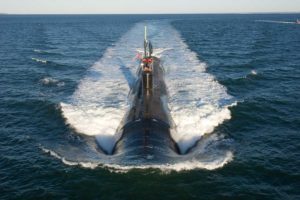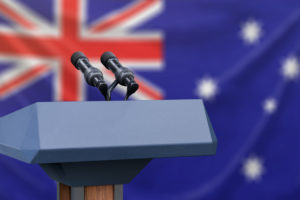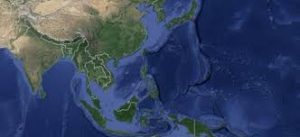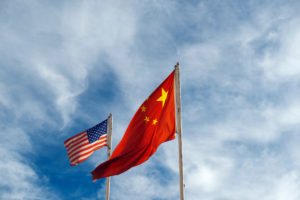October 2022
The year-old trilateral security partnership among Australia, the United Kingdom, and the United States—AUKUS for short—has the potential to alter the international research and development landscape, providing a blueprint for how allied countries can work closely together to develop advanced technology in critical areas. Historically, while not perfect, mechanisms have existed that allowed basic research to be conducted among international partners leveraging open research exchanges and collaborations. However, as technologies get closer to deployment, governments are less willing to share progress and knowledge, often with good reason. With innovative structures and targeted incentives aimed at overcoming traditional obstacles, AUKUS could demonstrate how joint efforts to develop advanced national security capabilities in areas like cybersecurity, artificial intelligence, quantum computing, and others can not only work, but create better technologies and systems on an accelerated timeline.
This is not a secondary consideration for the partnership; it gets at the heart of AUKUS and is indeed critical to supporting the shared security interests of the three countries and to maintaining the international rules-based order, both cited as objectives of AUKUS in the Joint Leaders Statement announcing the pact. The three AUKUS countries and their democratic allies are in a high-stakes technology competition with China. This is not dissimilar to the space race of the 1960s between the United States and the former Soviet Union, and the winner of this race will have an advantage in efforts to proliferate their world view—through both their leadership in and sharing of technology, as well as their ability to influence the global standards for how that technology is wielded. In other words, the development of the next generation of world-changing technologies is critical to what President Biden calls the central challenge of our time: the defense of democracy.
While AUKUS has formidable hurdles to overcome to reach its true potential for advancing research and development of new technologies, the three countries can begin outlining an approach to developing a research agenda aimed at addressing priority topical threats. At the same time, the three countries can begin identifying the components necessary to develop new structures and mechanisms that will both enable and incentivize progress on joint efforts.
Current Research Priorities
The three countries have already outlined core technological areas to focus on, with the first priority being the sharing of nuclear-powered submarine technology with Australia. This is notable not only because it caused a diplomatic spat with another core U.S. ally, but because it demonstrates the seriousness and commitment of the U.S. government to shoring up hard-power defense capabilities in the Indo-Pacific region. Alongside nuclear submarine technology, the AUKUS countries have highlighted cybersecurity, artificial intelligence, quantum computing, hypersonics, electronic warfare, and additional underseas capabilities to “enhance our joint capabilities and interoperability.” This is a good list, and one that is clearly aimed at impacting the information and knowledge environments, the soft-power components that can help determine geopolitical influence.
Core to this is artificial intelligence (AI), an underlying technology that will impact all other areas. As the National Security Commission on Artificial Intelligence states, AI is a “field of fields,” a dual-use technology that will underpin advances in other technological areas like cybersecurity, quantum computing, and electronic warfare—creating greater capabilities, but also greater threats. Global leadership in AI will be highly influential in determining global leadership in other technological areas.
AI will also be a key determining factor in the competition between democracy and autocracy, and China is well-positioned to compete for global leadership in this field. It is investing heavily in AI research and has other inherent advantages over its democratic counterparts, notably its ability to centrally vacuum up massive amounts of data on its citizens to feed and improve the algorithms that underpin AI. This can become a powerful tool to help autocratic regimes stay in power while also allowing them to set international standards for how AI is wielded. For democratic allies to compete, they will need to work collaboratively, bring interdisciplinary perspectives to the field of AI, and identify mechanisms for information-sharing.
AUKUS can play an important role here by prioritizing collaborative research and leveraging complimentary strengths of the alliance partners in areas identified above, including advancements in artificial intelligence and mitigation of potential threats.
Advancing Research to Address Security Threats
As Dr. Mariana Mazzucato notes, efforts at “big science deployed to meet big problems” are different today than they were in decades past. They center less on achieving a specific technological goal—like putting a person on the moon—and more on combatting persistent challenges and threats with no clear end-state.
“While missions of the past aimed to develop a particular technology (with the achievement of the technological objective signaling that the mission was accomplished), contemporary missions address broader and more persistent challenges, which require long-term commitments to the development of technological solutions,” Mazzucato says.
This framing of technological needs around long-term security challenges can be useful for AUKUS leaders. At the same time, the long-term commitment to addressing persistent challenges needs to be balanced with well-scoped projects allowing for (often revolutionary) progress and advances in high-priority research areas. This is a key element of Defense Advanced Research Projects Agency’s (DARPA’s) success; its programs are often aimed at addressing narrow project goals while simultaneously advancing broad national security priorities. Taking a similar tack—explicitly stating the broad security challenges important to AUKUS alongside developing specific problem-statements for researchers to work toward solving—could help boost AUKUS-led research efforts.
For example, one persistent challenge that threatens the security of countries in the Indo-Pacific region is combatting adversarial influence operations. China has demonstrated a propensity and acumen for executing sophisticated information operations and interfering in the national political debates of regional countries in order to ensure policies and outcomes that are favorable to its interests.
This is a significant threat to democracy that no one country can tackle alone. It is a global problem that capitalizes on globally available technology and, as such, requires a global response. AUKUS, a pact of three countries that already have close intelligence ties as members of the Five Eyes Intelligence Alliance, could develop comprehensive frameworks aimed at stemming the spread of disinformation and the impact of influence operations. Such an effort would necessarily include research and development in areas of cybersecurity and artificial intelligence, among others, while giving researchers a shared mission and clear goal to work toward.
Other global security challenges AUKUS could explicitly seek to address include building more resiliency and robustness into the semiconductor supply chain and protecting critical infrastructure against cyberattacks.
Structures and Mechanisms Necessary for Progress
To make headway on these challenges, AUKUS should look to the U.S. research ecosystem as a model to build on. In the United States, government, the private sector, and academia interact and collaborate to drive technological progress, sometimes quickly and sometimes over long periods of time. While this innovation ecosystem can struggle with operationalizing new technologies—it can take decades, in some cases—it has an unparalleled track record of producing world-changing capabilities.
The transition and deployment of advanced technologies from basic research to operational use is a key national security challenge, in part because it can be difficult to find personnel with the necessary combination of expertise in both the research component (technical depth) and the mission needs the research is attempting to ultimately address. As a result, new technologies developed in university research labs often fall prey to the Valley of Death, the gap between the development of a new technology and its translation into actual deployment and use. This is a challenge AUKUS leaders will need to be cognizant of and be willing to develop new structures to overcome. The three countries have a foundation to build on as a result of decades of working closely together as members of the Five Eyes Alliance, thus allowing collaboration not only on the research but also on transition of that research into practice.
In the United States, mission-focused funding agencies have played a crucial role in the development of an innovation ecosystem that enables transition, with DARPA as the premier model. DARPA’s high-risk, high-reward ethos aims to propel revolutionary progress around an existing or emerging mission need. In addition to being able to address national security problems, DARPA has historically spurred innovation in the private sector by de-risking early-stage technologies. Examples include the global positioning system (GPS), unmanned aerial vehicles, and, most famously, the precursor to the internet, ARPANET.
The United Kingdom is standing up a DARPA-like entity called the Advanced Research and Invention Agency, and there has been some discussion on the topic in Australia as well, though those discussions remain in the realm of political debate. These are welcome developments that could be leveraged for AUKUS’ research and development goals, particularly if AUKUS leaders can get the domestic political buy-in necessary to cut through red tape and develop innovative mechanisms to allow for funding that can be distributed to innovators in any of the three countries. But caution is necessary: previous efforts to replicate DARPA—in other countries and even within the United States by other federal agencies—have seen varying degrees of success, in part due to difficulties in reproducing a culture that is comfortable with failure even when large amounts of money have been invested in an idea.
U.S. national laboratories are another model AUKUS could look at, specifically University Affiliated Research Centers (UARCs) and Federally Funded Research and Development Centers (FFRDCs). These entities create environments that bring together top researchers on mission-specific problems with a clear focus on creating technologies that will be transitioned into use. Their close, direct relationships with mission-focused agencies, along with insight into technology deployment, give them in-depth understanding of mission needs that is difficult to replicate, and their personnel and researchers are comfortable bridging the divide between open research and classified or closed research.
A three-pronged strategy could help take this approach to the next level:
- Continued commitment to and investment in the research ecosystem by AUKUS member countries
- Designing and accelerating mechanisms for joint initiatives, leveraging unique alliance strengths
- Creating a “space” for an AUKUS lab to accelerate transition and deployment of advanced capability
The first, commitment to research ecosystems, particularly in the national security mission space, requires continued investment and leadership in research within each member country. For the United States, investments under the oversight of Undersecretary of Defense for Research and Engineering (including DARPA) are key, especially in the areas outlined above.
The second, mechanisms for collaboration, should build upon existing strengths and benefits of the alliance, such as the infrastructures in place to support the Five Eyes. Additionally, while China has advantages in its ability to collect and process large amounts of unrestricted data, progress in some research areas—such as assured and human-centered autonomy—is advancing at a faster rate in the United States. Additionally, the United States still attracts much of the world’s best scientific talent, in part because of the openness and freedom of the U.S. research ecosystem. Recent initiatives aimed at promoting more interdisciplinary research by major research funding agencies like the National Science Foundation also position the alliance competitively.
Finally, creating a space for an AUKUS “lab” would provide the collaborative environment necessary to allow researchers to work together with mission-focused domain experts from across the AUKUS countries, just as U.S. national labs provide this capability domestically. An innovative approach could include supporting environments that not only allow cleared researchers to work on security problems, but that support the entire technology readiness spectrum—from collaborations between academics on basic research, to industry and national lab researchers on applied research, to mature capabilities positioned for deployment.
The creation of AUKUS opens up an opportunity to marry the strengths of three global leaders in research and development while also helping to defend democracy, bridge the valley of death, and create new capabilities. With some creativity and sustained political support, AUKUS could leverage both member nation and alliance strengths to create something far more impactful than the sum of its individual parts. It could create a blueprint for advancing democratic security interests far beyond the Indo-Pacific region and to the rest of the world.
